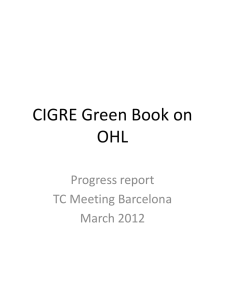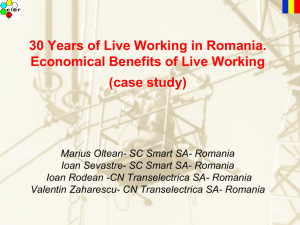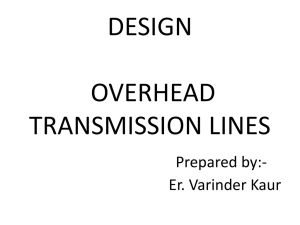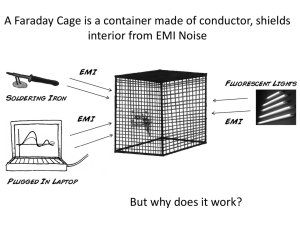Case Study on Increasing the Transport Capacity of 220 kv
advertisement
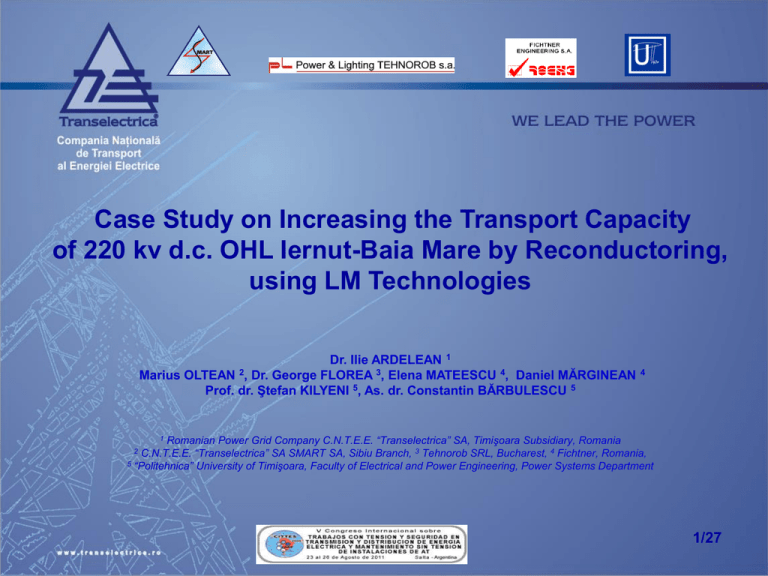
Case Study on Increasing the Transport Capacity of 220 kv d.c. OHL Iernut-Baia Mare by Reconductoring, using LM Technologies Dr. Ilie ARDELEAN 1 Marius OLTEAN 2, Dr. George FLOREA 3, Elena MATEESCU 4, Daniel MĂRGINEAN Prof. dr. Ştefan KILYENI 5, As. dr. Constantin BĂRBULESCU 5 4 Romanian Power Grid Company C.N.T.E.E. “Transelectrica” SA, Timişoara Subsidiary, Romania C.N.T.E.E. “Transelectrica” SA SMART SA, Sibiu Branch, 3 Tehnorob SRL, Bucharest, 4 Fichtner, Romania, 5 “Politehnica” University of Timişoara, Faculty of Electrical and Power Engineering, Power Systems Department 1 2 1/27 Content 1. Introduction 2. OHL identification in the West part of NPG, in which the reconductoring has maximum efficiency 3. Adopted reconductoring solutions and types of conductors used 4. LM technologies proposed for implementation 5. Evaluation of economical efficiency of reconductoring 6. Conclusions 2/27 1. Introduction New OHL - difficulties in obtaining land for clearway Arguments for increased transport capacity of existing OHL - increasing power consumption - connection new renewable sources (wind) to NPG - network congestions Solutions to increase transmission capacity of the OHL - uprating: - increasing the current value - increasing the voltage value - increasing both values of current and voltage 3/27 1. Introduction Summary of key methods and instruments used to increase OHL capacity - Table 1 Table 1 4/27 2. OHL identification in the West part of NPG, in which the reconductoring has maximum efficiency Software tool is designed in Matlab environment enjoying the entire characteristics specific to Microsoft Windows operating systems, having a user friendly interface The flowchart is presented in Fig. 1 Fig. 1 5/27 2. OHL identification in the West part of NPG, in which the reconductoring has maximum efficiency Report generated by the software application – Fig. 2 For the case of each congested branch, two kind of information are available: - the sample containing the congested branch - the scenarios leading to the issues pointed-out Fig. 2 6/27 2. OHL identification in the West part of NPG, in which the reconductoring has maximum efficiency -5 7 .2 M VR GADALIN 28037 UNGHE.A 28459 84 XRO_ M U1 1 IERNUT 5 29159 193 MW 1 1 8 M VR ROS IORI 28039 ORAD II 28839 ORADEA 28096 5 0 .6 M W -0 .1 M VR 7 8 .9 M W 1 8 .2 M VR 7 1 .0 M W 1 2 .5 M VR 1 6 .1 M W -0 .7 M VR 5 9 .2 M W 1 2 .9 M VR 1 2 6 .7 M W 3 .9 M VR 28069 ARAD 28485 BAIA M A 2 0 M VR LOTRU 28040 LOTRU 1 29232 29169 M INTIA 5 1 29233 LOTRU 2 0 .0 M W 0 .0 M VR 2 S IBIU 28100 S IBIU 28034 1 2 2 8 .4 M W 7 3 .5 M VR 28538 S IBIU S 2 7 7 .1 M W -1 4 .9 M VR 2 2 29167 M INTIA 1 28792 PES TIS 28070 S ACALAZ 5 1 .7 M W 7 .7 M VR 28068 M INTIA B 28003 M INTIA 28067 M INTIA A 5 5 .8 M W 9 .5 M VR 7 2 .3 M W -1 2 .4 M VR 6 1 .6 M W -1 6 .6 M VR 28756 S ACALAZ 28066 PES TIS -1 0 0 .6 M VR 29162 RETEZAT1 2 29262 M INTIA 6 1 6 .2 M W -1 .4 M VR M INTIA 28787 28071 TIM IS 29260 M INTIA 3 HAJD OT. 28065 2 1 .7 M VR 2 1 .9 M VR 1 5 0 .8 M W 1 5 7 .6 M W 28914 R.M ARE 1 4 7 .4 M W 7 .2 M VR HAS DAT 28795 4 5 .4 M W -8 .0 M VR BARU M 28064 PAROS EN 28063 1 .2 M W 0 .6 M VR 3 9 .8 M W 8 M VR 2 28746 TIM IS A 28747 TIM IS B 7 9 .2 M W 9 .1 M VR 70 MW 6 M VR 1 7 .8 M W 9 .9 M VR BARU M A 28800 8 4 .8 M W 4 6 .9 M VR 2 5 .7 M W -4 .4 M VR 4 3 .8 M W 3 .6 M VR 1 8 .6 M W 6 .1 M VR 28808 PAROS 7 5 .0 M W 1 0 .8 M VR EN 2 28737 IAZ B 28736 IAZ A 6 3 .6 M W 7 .1 M VR 28062 5 3 .8 M W TG.JIU 6 5 .5 M VR 26 MW 1 9 .8 M VR 28054 IAZ 1 28694 URECHES T 28053 IAZ 2 2 3 .8 M W 1 0 .9 M VR 9 1 .2 M W 4 1 .6 M VR 28052 RES ITA 28045 URECHES I 1 0 .1 M W 1 .5 M VR 0 MW 0 M VR 29119 ROVIN 5 28729 RES ITA A 29120 ROVIN 6 2 2 9 .6 M W 1 0 9 M VR 29121 ROVIN 3 2 5 8 .3 M W 4 7 .2 M VR 29238 ROVIN 4 0 MW 0 M VR 29455 ROVIN 7 28002 URECHES I 6 6 .0 M W 3 9 .3 M W 0 .4 M VR 2 1 .3 M VR 3 .0 M VR 2 1 .9 M W 1 8 .7 M W -1 1 .1 M VR 7 .4 M W 3 .4 M VR 2 28719 TR.S .ES 29102 CETATE 1 1 1 .5 M W -7 M VR 28048 TR.S EV 6 2 9 .7 M W -6 6 .4 M VR 28709 CALAFAT 8 1 .8 M W -2 7 M VR 29250 P.D.F.6 269 MW 1 0 9 M VR 57 MW 1 5 .2 M VR 28730 RES ITA B 1 29189 P.D.F 1 5 0 .1 M W 1 9 .1 M VR 8 9 .2 M W -1 .4 M VR 4 8 .9 M W 1 8 .7 M VR 0 MW -0 .9 M VR 9 8 .2 M W -1 1 .4 M VR 1 5 0 .0 M W 2 2 .1 M VR 1 5 .9 M W 2 .7 M VR 1 1 1 .5 M W -7 M VR S IBIU S B 28537 LOTRU 28562 9 9 .0 M W -1 1 .3 M VR 1 .0 M W 1 6 .9 M VR 28775 ARAD B 1 1 5 9 .2 M W 5 7 .1 M W 1 2 .3 M VR 1 2 3 .2 M W 5 .0 M VR 28460 UNGHE.B CUPT.C.T 28088 5 2 .1 M W 1 4 .3 M VR 28008 ARAD The case study is carried-out for the West and South-West side of the Romanian Power System – Fig. 3 It has 88 buses and 107 branches The power system is operated by the Romanian Power Grid Company Transelectrica, Timisoara Subsidiary and partially by Craiova and Cluj-Napoca subsidiaries. VETIS 28095 2 28774 ARAD A 2 5 .5 M W 4 .7 M VR 1 1 3 .8 M W 0 .6 M VR VETIS 28491 UNGHENI 28086 IERNUT 28036 85% 8 2 .5 M W -3 .2 M VR 8 5 .1 M W 2 1 .1 M VR ROS IORI 28094 BAIA M . 28093 0 .5 M W 0 .0 M VR 8 7 .2 M W 1 6 .5 M VR -1 7 9 .2 M VR IERNUT 28524 1 7 .5 M W -1 1 .7 M VR BAIA M A3 28484 75 XS A_ AR1 1 CLUJ E 28038 CLUJ ES 28509 -9 6 .6 M VR 2 1 9 .8 M W -6 0 M VR 193 MW 1 1 1 M VR IERNUT 28087 86% IERNUT 6 29160 28049 TR.S EV 1 4 .8 M W -1 2 M VR 28050 CETATE1 28051 CALAFAT 28047 P.D.F.A 28046 P.D.F.B 1 1 1 .5 M W 8 .1 M VR 1 1 1 .5 M W 8 .1 M VR 2 29191 P.D.F 3 29192 P.D.F 4 1 1 1 .5 M W -7 M VR 29190 P.D.F 2 29193 P.D.F 5 1 1 1 1 .5 M W -7 M VR 28004 P.D.FIE Fig. 3 3 2 7 .9 M W -2 2 .3 M VR 85 XPF_ DJ1 1 6 2 .6 M W 2 2 .8 M VR 7/27 2. OHL identification in the West part of NPG, in which the reconductoring has maximum efficiency The analyses have been performed for 1000 samples, each sample representing an individual operating condition. Based on the analyses the following OHLs have been selected: - 220 kV OHL Iernut-Baia Mare; - 220 kV OHL Portile de Fier-Resita. The beginning of the works at 400 kV corridor Portile de Fier-Resita-Timisoara-Arad and the tie-line with the Serbian power system (Resita-Pancevo) represent a case in point Iernut-Baia Mare 220 kV OHL has been selected having the maximum reconductoring efficiency 8/27 3. Adopted reconductoring solutions and types of conductors used Structural characteristics of the selected OHL are: • putting into operation 1969 • total length 162.4 km • no.towers 480 pcs. (of which: normal suspension 387 pcs., special suspension 15 pcs., tension 78 pcs.) • towers names type SNY, SSY, ICNY, INY, ICN, ICT • active conductor Al/Ol 450/75 mm2 • shield conductors: 1-55 dead end and 64-122 dead end St 70 mm2; 55-64 terminals St 95 mm2 • insulation CTS 120-2P şi CTS 160 (glass insulators with 146 mm, respectively 170 mm heights). 9/27 3. Adopted reconductoring solutions and types of Table 2 conductors used HTLS types of conductors that are currently on the market, are summarized in Table 2 10/27 3. Adopted reconductoring solutions and types of conductors used On existing lines, increased transmission capacity is restricted by the existing structure security. To maintain safe operation of the line, reusing the towers and insulator chains, in case of using unconventional conductors (compact, HTLS), the next restrictions must be followed: The new conductor diameter must be less or equal then the existing conductor diameter (29,25 mm) The maximum horizontal traction of the new conductor, must not exceed the existing conductor traction (Tmax = 5362 daN), in order to reduce the impact against the poles and foundations The final sag of the new conductor, at maximum operating temperature, to be limited to the final arrow of existing ACSR type conductor 450/75 mm2 The breaking force of the new conductor should be greater or at least equal with the existing conductor AlOl type 450/75 mm2 Electrical distances must be maintained 11/27 3. Adopted reconductoring solutions and types of conductors used Table 3 The main technical and physical data of conductors selected for analysis – Table 3 12/27 3. Adopted reconductoring solutions and types of conductors used Table 4 Physical parameters for HTLS conductors – Table 4 13/27 3. Adopted reconductoring solutions and types of conductors used Table 5 Real carrying capacity for HTLS conductors– Table 5 14/27 4. LM technologies proposed for implementation Critical circuits reconductoring, a solution with clear benefits, which may increase thermic capacity twice or more, faces two major obstacles: involved towers, in most cases, have the life span very high (close to the lifetime) and if the maintenance works were not made under the rules, they will be repaired and strengthened circuits which have the greatest need to be reconductorated are usually the most difficult to be withdrawn from operation. If you can’t find a way to achieve LMT for the whole work, it is necessary to find combined technologies with which to achieve reconductoring works with the line withdrawn from service and into a short a period of time. 15/27 4. LM technologies proposed for implementation Taking into account the existing technologies at this time in Romania and the existing facilities, there are imposed some restrictions in applying the live-line technologies to this line: there can’t be done works at the towers on the middle phase on 220 kV single circuit OHL there can’t be performed works on the energized upper phases, on double circuit segment of that line (towers 470-472) For this reason the live-line technology will be applied only to two of the three phases of the line. Preparatory work that can be done under voltage: vibration dampers removal clamps replacement at the lower roller yokes final work that can be done live-line: - vibration damper installation - suspension clamps mounting (clamping) 16/27 4. LM technologies proposed for implementation Table 6 Reconductoring deployment sequence work and line status - Table 6 17/27 4. LM technologies proposed for implementation The live-line progress of work necessarily involves attending the following: determining atmospheric conditions at the workplace by the Head of works preparation of ladder and chair equipping workers climbing on the poles with the conductive material suits and shoes with electroconductive soles training employees in the team and the allocation of duties undervoltage working authorization signature by all team members mounting the trolley at climbing pole worker shift from the trolley to phase wire trolley movement, directed from the ground with rope guidance truck passing on a support pole removing the trolley at descent pole completion of the work 18/27 5. Evaluation of economical efficiency of reconductoring For economic analysis of possible solutions of reconductoring with increased transportation capacity conductors were compared the variants with conductors who met the necessary technical conditions to achieve a corresponding increase in transmission capacity. In this analysis were examined two components: direct costs and maintenance total cost respectively cost of energy losses. Table 7 All costs below are calculated for a kilometer of three-phase circuit, equipped with one conductor per phase. In Table 7 are shown power losses calculation for different types of conductors. 19/27 5. Evaluation of economical efficiency of reconductoring Using a conductor with a specific resistance lower gives two advantages: lower losses and reduced operating temperature. Power losses values per unit in MW/km are shown in Fig. 4. Fig. 4 20/27 5. Evaluation of economical efficiency of reconductoring Taking into account (maximum) a carried power of 480 MVA for 8760 hours per year, present value of power losses for 30 years, with a discount rate of 8%, is shown in Fig. 5. Actualized costs of power losses 1482856 1279109 1600000 1143439 1052218 1400000 913862 Euro/km 1200000 1000000 800000 600000 400000 200000 Fig. 5 0 ACSS ZTACIR GZTACSR ACCR ACCC/TW 21/27 5. Evaluation of economical efficiency of reconductoring Total direct costs, including procurement, installation and maintenance upgrade, according to Fig. 6, are the lowest for ACSS conductor followed by GZTACSR. Direct costs (Euro/km) 217000 250000 144900 Euro/km 200000 150000 89200 83100 100000 46980 50000 0 Fig. 6 ACSS ZTACIR GZTACSR ACCR ACCC/TW Conductor 22/27 5. Evaluation of economical efficiency of reconductoring Finally the comparison of total costs (cost of losses + direct costs), as shown in Fig. 7 reveals that the ACSS and ACCC/TW are the most recommended conductors suitable for the examined case. Actualized total cost (direct + losses) 1566000 1368300 1600000 1400000 1360600 1099200 1058700 Euro/km 1200000 1000000 800000 600000 400000 200000 Fig. 7 0 ACSS ZTACIR GZTACSR ACCR ACCC/TW 23/27 6. Conclusions The software tool developed by the authors is designed for congestion management. It corresponds to the actual operating conditions, represented by the deregulated environment. Within the paper the results are used as an application for the reconductoring process Based on the analyses performed using the software two OHLs have been identified as candidates. One of them is suitable for reconductoring, having the highest efficiency The usage of HTLS type conductors on the 220 kV OHL Iernut-Baia Mare is technically feasible; all analyzed conductors, less TACSR, may be used, having a sag equal or less than the current one, but with a higher thermal current Similar diameters of wires lead to wind forces similar to those for which the line was designed and achieve a minimal visual impact The growth of thermal current implies an increase in the values of the magnetic field, but below the amount prescribed by the ICNIRP 24/27 6. Conclusions The ACCC and ACCR conductors, composite types, have the best mechanical and electrical pair of values characteristics; they are relatively new products on the market, are not yet widely used, and the direct cost is higher compared to other types ZTACIR type conductors are used mainly in Japan and Korea, and the direct cost for hese conductors is lower than that of the composites ones. Given the normal frost deposits on the analysed OHL, these types of conductors can be considered as a feasible solution GZTACSR type conductors can be considered feasible, subject to a special installation, the need for a training and a high maintenance ACSS type conductors have the lower direct costs correlated with a good electrical resistance, installation and maintenance comparable to conventional ACSR conductors ZTACIR type conductors are used mainly in Japan and Korea, and the direct cost for these conductors is lower than that of the composites ones. Given the normal frost deposits on the analysed OHL, these types of conductors can be considered as a feasible solution 25/27 6. Conclusions about the direct costs of procurement, installation and maintenance, the ACSS conductor type stands in first place, followed by the GZTACSR and ZTACIR conductor related to the costs of energy losses, the ACCC, ACSS and ACCR conductor types are located on top, in this order for reconductoring of the 220 kV OHL Iernut-Baia Mare is proposed the ACSS conductor type combined technology proposed for completion of the 220 kV OHL Iernut-Baia Mare 3 reconductoring greatly reduces the time of withdrawal operation. 26/27 Thank you for your attention ! Thank you for your attention ! 27/27
